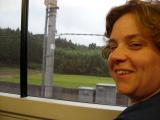
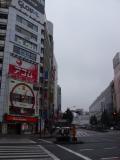
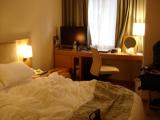
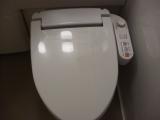
Jen and I spent a little under 48 hours in Tokyo, Japan in August, 2008. We were travelling to Korea for the 2008 World Amateur Radio Direction Finding Championship and wanted to spend a little time to see Tokyo on the way. Unfortunately, it was raining pretty much the entire time we were there and we were jet-lagged. We did visit the Tokyo National Museum, Ikihabara, and Shinjuku.
These photos are copyright © 2008 Kenneth E. Harker. All rights reserved.
 |
After arriving at Narita International Airport, we took the Narita Express train into the city. The train ride was about 75 minutes long. Near the airport, the scenery was semi-rural, with rice and soybean fields, but quickly became a suburban and then urban landscape. |
 |
Our hotel was in Shinjuku, one of the most densely populated areas of Tokyo. Shinjuku Station is supposedly the busiest train station in the world. This was a typical street intersection on a rainy Monday afternoon. |
 |
We spent two nights in the Hotel Sunroute Plaza Shinjuku. Sunroute is a major hotel chain in Japan. Our room was compact for two people with large suitcases, but it was more than adequate. |
 |
The hotel bathroom had one of those toilets with many buttons. And - a dial. |
In the morning, we took the train to the Tokyo National Museum. The Tokyo National Museum is located in Ueno Park, a large public park in downtown Tokyo that includes multiple museums, gardens, and pedestrian malls.
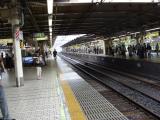 |
One of the train stations on our way. We pretty much stayed on the East Japan Railway Company lines, although the stations we used had lines for other subway/train systems. |
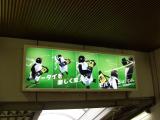 |
A billboard with penguins advertising the Suica card. We bought Suica cards in the airport when we bought our train tickets. They are RFID debit cards for the train system that supposedly can be used at some convenience stores as well. Some Japanese mobile phones have the Suica chipsets built-in so you don't have to carry a separate card. |
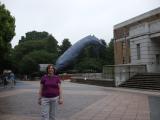 |
Jen, standing in front of the National Museum of Science and Nature, which had a lifesize sculpture of a humpback whale in front of it. This museum was on the walk from the train station to the National Museum. We did not have time to visit it. The rain was a light mist. |
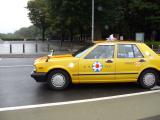 |
A Japanese taxi on the street in front of the National Museum. |
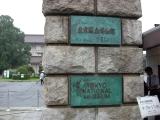 |
The Tokyo National Museum is the oldest and largest museum in Japan. It's actually a complex of five museum buildings. |
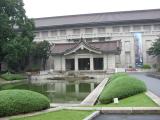 |
We only had time to explore inside the Honkan building, which houses the most important Japanese artwork and artifacts. We were not allowed to take photographs inside the museum. At least it was out of the rain. |
After lunch, we took the train to Akihabara. Akihabara is a part of Tokyo that is most famous for the Akihabara Electric Town, a large shopping district that is packed with stores selling everything from individual electronic components to consumer devices. The electric town developed around Tokyo Denki University, the first university in Japan to specialize in electronics and electrical manufacturing. Amateur radio operators around the world know that Akihabara has the largest concentration of amateur radio stores in the world.
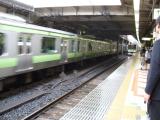 |
Trains at Ueno Station. |
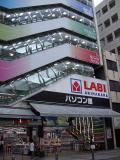 |
This is one of the multi-floor electronics department stores very close to the Akihabara train station. I liked the tubular glass around the escalators built into the front wall of the store. |
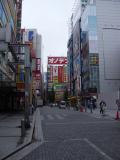 |
The street leading into the Electric Town area from the train station. On the right is a store selling Dell computers, one of the few non-Japanese consumer electronics brands we saw being sold. (The other major exceptions were Apple computers, Apple iPods, and Hewlett Packard printers - but no HP computers). Generally speaking, there were no Korean or Chinese brands in the stores. |
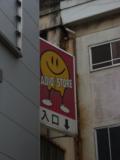 |
Radio Store! I have a feeling that this store sign has been there for decades. |
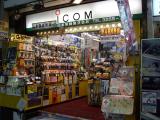 |
An Icom dealer in one of many, many alleys full of small stores. In addition to amateur radio equipment, this store is selling GPSs and some sort of wireless home automation products. |
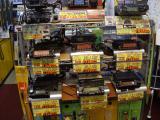 |
A display of amateur radio transceivers, including Alinco, Icom, and Yaesu models. Accounting for the exchange rate, these prices are very similar, and maybe slightly more expensive, than what these same radios would cost in the United States. |
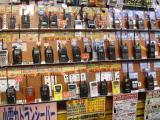 |
A wall of handheld transceivers. Some of these are amateur radio transceivers, others are for channelized, unlicensed UHF bands. |
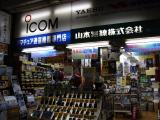 |
Another store selling Icom and Yaesu amateur radio products. Amateur radio stores in the United States would never have this many display models out for customers to examine. The two motorcycle helmets above the display of handheld transceivers are displaying specialized microphone accessories that one rarely sees in radio stores in the US. |
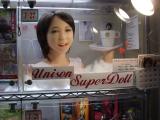 |
Not everything in Akihabara is radios. I'm not really sure how this is electronic, though. |
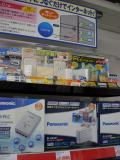 |
Inside one of the department stores, we came across this display of powerline communications devices. I think they were mostly for extending IP networks within a home using the AC wiring rather than broadband modems for use with a Broadband over Powerline service. |
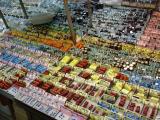 |
Deeper inside Akihabara, there are malls of very small stalls selling all sorts of electronics components. This shop was maybe two meters wide and sold only capacitors. The bowl in the upper left is used paying cash and giving change. |
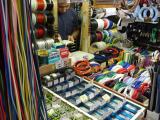 |
This stall sold mostly wire, but had a small selection of LEDs, diodes, transistors, and heat shrink. |
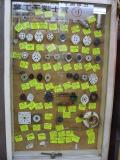 |
A display of vaccuum tube sockets for sale. The most expensive sockets have price tags approaching $45 USD. |
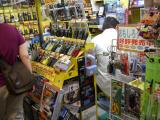 |
Another small amateur radio shop. This store was maybe 10' x 10'. |
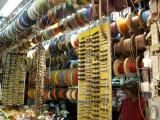 |
This stall was maybe 15' wide and sold only wire and coaxial cable. Unlike most of the smaller shops, the proprietor was a woman. |
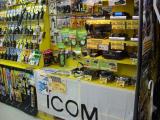 |
Another Icom dealer. There are so many small amateur radio shops selling exactly the same radios for exactly the same prices. You can see a copy of CQ ham radio magazine on the display. The magazine is actually not associated with the CQ Amateur Radio magazine sold in the United States. |
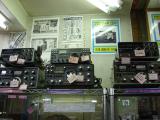 |
One shop in the upper floor of the Tokyo Radio Department Store Shopping Mall had dozens of vintage and collectible radios for sale. These are older Kenwood and Yaesu radios. The TS-700s are early models sold under the Trio brand mark in Japan (Kenwood in the USA). |
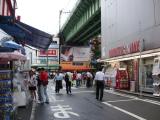 |
The street scene in Akihabara. The bridge overhead is an East Japan Railway line. The Icom billboard underneath the bridge is as large as a highway billboard in the USA. |
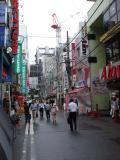 |
One of the alleys in Akihabara. The power pole and overhead lines, even in narrow streets like this, were typical of Tokyo. |
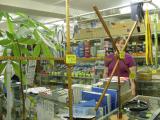 |
Among the few radio products we found in Akihabara that are not commonly found in US radio stores were these indoor receive-only antennas for medium wave DXing by Mizuho Sushin. |
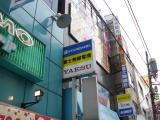 |
Standard, Yaesu, Kenwood, Icom, Alinco... |
After a day of sightseeing, we returned to the Shinjuku area. In the evening, we walked over to the Isetan department store specifically to see the food mall in the basement level. I was kind of surprised that there was nowhere to sit down and eat there. We ended up eating in a Japanese restaurant on the top floor and getting dessert in the food mall. The next morning, we enjoyed the sunshine on our trip back to the airport.
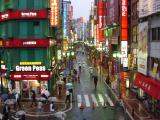 |
It was raining as we walked over to the department store. This was a street close to one of the Shinjuku Station exits. Streets like this did have car traffic, but not many drivers seemed to venture into them. You would think it would have something to do with food, but Green Peas is actually a pachinko parlor. |
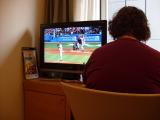 |
The next morning, Jen caught part of a Yankees-Red Sox baseball game being broadcast live on NHK. The TV in the hotel room had a "language" button, so we were able to get the Fox Sports announcers in English. During the breaks where the commercials were being aired in the US, we got the Japanese announcers instead. |
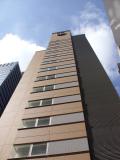 |
Our hotel, now in sunshine. |
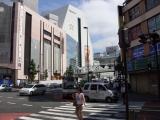 |
Shinjuku street scene on a Wednesday morning. |
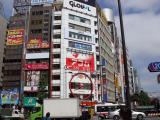 |
This building across the street from one of the Shinjuku Station exits had a giant, three-story-tall working clock face on it. |
We took the Narita Express train from Shinjuku Station back to the airport. Unlike the intercity trains, the Narita Express cars had reserved seating and large luggage racks for suitcases. They also had a snacks and drinks vendor onboard, but no AC power or WiFi.
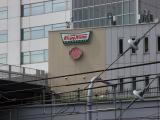 |
Next to the train line was a Krispy Kreme doughnuts sign. Krispy Kreme has only been in the Japanese market about a year and a half. I'm sure there must have been a way to get to the doughnut store from inside Shinjuku Station. |
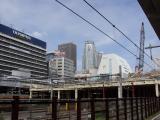 |
Some of the Shinjuku area skyline, as seen from the train platform. |
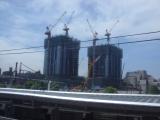 |
Twin skyscrapers being built. |
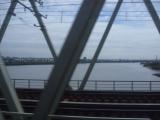 |
The train is crossing one of the rivers in Tokyo. |
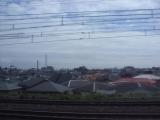 |
This neighborhood on the east side of Tokyo is far enough out that there is some single family housing. The rooflines in Japan tended to be straight, rather than curved. |
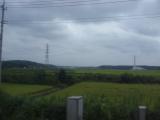 |
Far enough outside the city, you begin to encounter cultivated fields. |
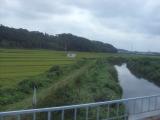 |
Terraced rice paddies and an irrigation canal. |
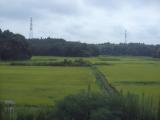 |
Fields of soybeans. |
| Last Updated 1 August 2018 |